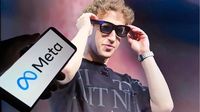Meta’s annual Connect 2025 developer conference was meant to be a crowning moment for the company’s push into augmented reality (AR) wearables. Instead, it became an unforgettable lesson in the unpredictability of live technology demos. On September 18, 2025, with the tech world watching, two high-profile demonstrations of Meta’s new AI-powered smart glasses malfunctioned on stage—leaving CEO Mark Zuckerberg and his team scrambling, and the internet abuzz with both schadenfreude and curiosity.
The event kicked off with fanfare as Zuckerberg introduced three new smart glasses: the second-generation Ray-Ban Meta, the Meta Ray-Ban Display (featuring a heads-up display and neural wristband controller), and the Oakley Meta Vanguard, a sports-focused model. These devices, with the Ray-Ban Display model priced at $799, were pitched as the next leap in wearable computing—promising to overlay digital information in users’ field of view and provide seamless, AI-driven assistance throughout the day. According to TechCrunch, Meta’s vision is nothing short of revolutionary: smart glasses plus AI as the successor to the smartphone, blending style and technology into an always-on digital companion.
But as the spotlight turned to live demonstrations, things quickly went awry. The first stumble came during a cooking demo with food influencer Jack Mancuso. Wearing the new Ray-Ban Meta glasses, Mancuso asked the AI assistant for step-by-step help with a steak sauce recipe. Instead of providing guidance, the glasses fell silent, then abruptly skipped ahead in the recipe, ignoring his repeated prompts. Flustered, Mancuso joked, “maybe the Wi-Fi is messed up,” before tossing the demo back to Zuckerberg. The audience chuckled, but the tension was palpable. As Fox Business reported, Zuckerberg tried to smooth things over: “You practice these things like a hundred times, and then you never know what’s gonna happen.”
The next demo was even more cringe-inducing. Zuckerberg attempted to answer a WhatsApp video call from Meta CTO Andrew Bosworth using the Ray-Ban Display glasses and the new neural wristband. Despite multiple attempts at the designated hand gesture, the call would not connect. After several awkward moments, Bosworth had to walk onstage in person, joking about the “brutal Wi-Fi.” Clips of the mishap quickly made the rounds online, with one Reddit user calling it “solid comedy gold.”
Initially, Zuckerberg and others blamed the failures on poor Wi-Fi—a reasonable guess in a packed auditorium brimming with devices. But the real story, as revealed the next day, was far more technical and, in some ways, more reassuring. Bosworth took to Instagram for a candid Q&A, offering a detailed postmortem. The culprit for the cooking demo, he explained, was a “mistake in resource management planning.” When Mancuso said, “Hey Meta, start Live AI,” the wake phrase triggered every Ray-Ban Meta in the building—hundreds of devices, not just the one on stage. This unexpected mass activation flooded Meta’s development server, creating a self-induced DDoS (distributed denial of service) that overwhelmed the AI assistant and caused it to malfunction. “So we DDoS’d ourselves, basically, with that demo,” Bosworth admitted with a rueful smile.
The WhatsApp call failure, meanwhile, was caused by a rare software bug known as a “race condition.” As Bosworth described, the glasses’ display went to sleep just as the call came in, so when Zuckerberg tried to wake the display, the incoming call notification never appeared. “We’ve never run into that bug before,” Bosworth said. “That’s the first time we’d ever seen it. It’s fixed now, and that’s a terrible, terrible place for that bug to show up.”
Importantly, Bosworth stressed that these were demo failures, not product failures. “Obviously, I don’t love it, but I know the product works. I know it has the goods. So it really was just a demo fail and not, like, a product failure,” he told TechCrunch. The issues were quickly fixed through software updates, and many journalists who tested the glasses immediately after the keynote reported positive experiences. According to TechRadar, the Ray-Ban Display glasses performed impressively in hands-on trials, delivering notifications, directions, and real-time AI help as promised.
Meta’s transparency in handling the snafu drew praise from some corners of the tech world. Rather than downplaying the incident or sticking to a vague “it was the Wi-Fi” excuse, Bosworth’s detailed technical explanation was seen as refreshingly candid. As Virtual Reality News noted, this level of openness is rare in big tech and can actually build confidence among developers and power users, showing that Meta’s engineers know the stack and are capable of fixing issues quickly.
Still, the demo failures fueled public skepticism and internet humor. Social media lit up with jokes about Zuckerberg’s struggles and the glasses “needing glasses.” Some questioned whether Meta’s AR vision was ready for prime time, especially as the company races against Apple’s Vision Pro and Snap’s forthcoming AR Spectacles to define the future of wearable computing. As Cybernews pointed out, the incident gave ammunition to critics who view Meta’s AR push as overhyped or premature.
Yet, for every meme or critical tweet, there were also voices urging perspective. Industry veterans recalled that even Apple and Microsoft have suffered infamous live demo failures. What matters, they argued, is how a company responds—and Meta’s swift fixes and willingness to “own” the mistake have, if anything, reinforced its commitment to innovation. As Bosworth put it, “The tech works, but a live stage is a stress test with the volume turned up.”
From a strategic standpoint, the Connect 2025 flop is a small stumble on a long and ambitious road. Meta’s Reality Labs division is burning billions annually to make AR and VR mainstream, betting that devices like the Ray-Ban Display glasses can eventually replace the smartphone. The company’s new Wearable Device Access Toolkit (WDAT) aims to jump-start an ecosystem of third-party AR apps, inviting developers to build novel experiences on its platform. Early sales numbers are promising—Meta has already sold over 2 million first-generation Ray-Ban Meta glasses since 2023, according to Cybernews.
Competition is fierce, with Apple, Snap, Google, and others all vying for a piece of the AR future. Apple’s Vision Pro, while more expensive and less socially wearable, has set a high bar for polish and performance. Snap’s upcoming AR Specs are expected to leverage the company’s popular AR Lenses to entice a younger, social media-savvy audience. Meta’s advantage may lie in its willingness to take risks and iterate in public—even if that means enduring the occasional embarrassing demo fail.
Ultimately, the real test for Meta’s smart glasses will come not in the glare of a keynote spotlight, but in the hands and on the faces of everyday users. If the technology delivers on its promise—reliably providing AI assistance, navigation, and communication in a form factor people actually want to wear—the Connect 2025 demo will be remembered as a blip, not a blunder. As Bosworth noted, “It’s fixed now,” and the company is moving forward, undeterred.
Meta’s stumble at Connect 2025 was a humbling moment, but also an instructive one. It highlighted both the complexity and the promise of bringing AR and AI together in real-world products. For now, the race to own the future of wearable tech is still wide open—and Meta, despite a bruised ego, remains very much in the running.






